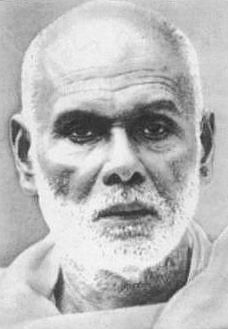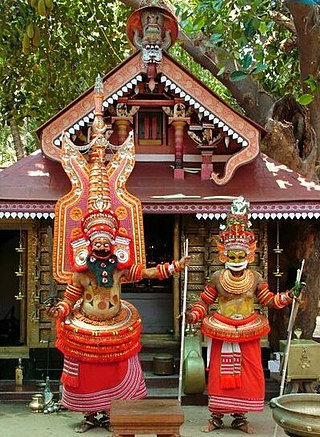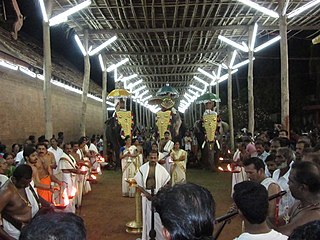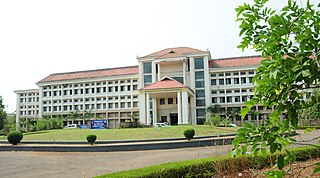
Sree Narayana Guru was a philosopher, spiritual leader and social reformer in India. He led a reform movement against the injustice in the caste-ridden society of Kerala in order to promote spiritual enlightenment and social equality. A quote of his that has become popular: "one caste, one religion, and one god for all men". He is the author of the Advaita poem Daiva Dasakam, which is one of the most used poem in Kerala for community prayer.

Muthappan is a deity commonly worshiped in the Kannur, Kasargod, Kozhikode, Malappuram region of Kerala and Coorg region of Karnataka in India. Muthappan is considered as the personification of two Hindu gods — the Thiruvappan or Valiya Muthapan (Vishnu) and the Vellatom or Cheriya Muthapan (Shiva).
Kunnathur Padi is the historic center for the folk Hindu deity Sree Muthappan. The center stands in Payyavoor Grama Panchayat, Kannur District of the Kerala state of India, 3,000 feet above sea level, on top of Udumbumala in the Sahyadri mountains. The region belonged to the kingdom of the Mannanar dynasty, the line of Muttappan. In 1902, Kunhikelapan Mannanar, the last king of this dynasty of Muthappan's clan, was killed and the British government seized the property of this dynasty, and Karakattidam Nayanar, a Nair landlord, got the right to manage Kunnathur Padi.
Edakkad is part of the Kannur Municipal Corporation in Kannur District of Kerala state, in India.

Sivagiri is an area in Varkala Municipality of Thiruvananthapuram district in Kerala. It is a pilgrimage centre of Varkala Town where the tomb, or samadhi, of Sree Narayana Guru is situated. It is a place where Guru built the Sarada Temple dedicated to Sarada Devi. The tomb is an attraction for thousands of devotees every year, especially during the Sivagiri Pilgrimage days from 30 December to 1 January.

The Ezhavas are a community with origins in the region of India presently known as Kerala, where in the 2010s they constituted about 23% of the population and were reported to be the largest Hindu community. The Malabar Ezhava group have claimed a higher ranking in the Hindu caste system than do the others, although from the perspective of the colonial and subsequent administrations they were treated as being of similar rank.

T. K. Madhavan Alias Deshabhimani Madhavan, was an Indian social reformer, journalist and revolutionary, who was involved with the Sree Narayana Dharma Paripalana Yogam. He hailed from Kerala and led the struggle against Social discrimination which was known as Vaikom Satyagraha.

Moorkoth Kumaran (1874–1941) was a social reformer, a teacher and a writer in Malayalam. He came from a Thiyya family of Telicherry. He was a disciple of Narayana Guru and wrote the first biography of Guru. He also published some of the earliest short stories and novels in Malayalam.

Narayana Guru built temples at various locations in India: Kollam, Thiruvananthapuram, Thrissur, Kannur, Anchuthengu, Thalassery, Kozhikode, Mangalore. Some of the temples built by the guru are:

The Sree Narayana Dharma Paripalana Yogam (S.N.D.P) is a social service organization that has been representing the Ezhava community from the Indian state of Kerala since 1903.

C. V. Kunhiraman was an Indian social reformer, journalist and the founder of Kerala Kaumudi daily. A follower of Sree Narayana Guru, Kunhiraman was the author of a number of books covering the genres of novels, short story, poetry, biographies and essays. He was one of the leaders involved in the Vaikom Satyagraha of Reformation movement in Kerala which led to the Temple Entry Proclamation.
Changaramkumarath Krishnan Vakkeel was a community leader, banker, social reformer, and journalist from Kerala, India. He was a champion of implementing the revolutionary socialist reforms proposed by Sree Narayana Guru for the upliftment of the downtrodden people of Kerala. He was called Mithavathi―a minimalist―after the newspaper he published from 1913 to 1938 to spread the message of the reformist movement. He was well-educated and hailed from an influential family. Although he could have entered the government service and risen to higher positions with his education and wealth, he renounced all these for the liberation of the backward classes from the clutch of pathological social system.
There are places of worship considered important in the Kannur district. Kannur District is one of the 14 districts in the state of Kerala, India. The town of Kannur is the district headquarters, and gives the district its name.

Peringottukara is a village in the western coastal side of India, located on the western side of Thrissur district, Kerala. The village is much famous for Vishnumaya Temples. Peringottukara village includes kizhakkumuri, vadakkumuri, and peringottukara center. Peringottukara village has main two junctions, the four-way junction, and three-way junction. The four-way junction has a petrol pump, three-star hotel, hypermarket, nationalized bank, Co-operative banks, and grocery stores. Peringottukara 3 way junction also has the same facilities. There are Chathan Seva temples at Peringottukara, such as Kanadi Kavu, Avanangattu Kalari, and Devasthanam. Among these Avanangattu Kalari is the biggest and oldest Temple. The biggest building, Shiva Parvathy Vishnumaya Terracotta Statue in Kerala is situated in front of the Peringottukara devasthanam, Its height is 52 ft.
Mannanthala Anandavalleshwaram Devi Temple is a Hindu temple in the Mannanthala suburb of Thiruvananthapuram, India.

Annapoorneshwari Temple is a Hindu temple situated in Kannur, Kerala. The deity is worshipped as Annapurneshwari (Annapurna), the goddess of food.
The Thalassery carnival, the Beach fest in Muzhappilangad beach and Dharmadam beach are notable attractions. The area's four rivers around Thalassery town and four beaches with more in Kannur also attract visitors.

Sree Narayana Guru College of Engineering & Technology was established in 2003 by Sree Bhakthi Samvardhani Yogam. It is named after Sree Narayana Guru (1855–1928).

The Kallingal Madathil Rarichan Moopan (1856–1919) was a Jenmi in Kozhikode. He was a social reformer of Malabar. He is known for community development and other social services.











